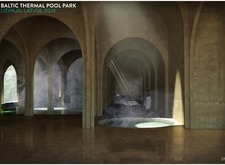5 key facts about this project
The architecture of the project employs a coherent design language that reflects the surrounding urban fabric. The structure’s silhouette is characterized by a series of interconnected forms that create an inviting presence. Large windows and open spaces throughout the building enhance natural light, minimizing the need for artificial lighting during the day. This emphasis on transparency not only contributes to a welcoming atmosphere but also promotes visual interactions between the interior and the exterior, engaging the public and blurring the lines between inside and outside.
One of the essential elements of the design is the façade, which elegantly balances aesthetics and functionality. The choice of materials—primarily concrete, glass, steel, and timber—creates a dialogue between modernity and warmth. Concrete serves as the structural backbone, offering durability while the expansive use of glass invites the outside in, showcasing the vibrancy of the environment. The steel framework provides a contemporary edge, and the incorporation of wood elements adds a natural softness that is inviting and comforting.
Sustainability is a core principle woven throughout the project. Intentional decisions regarding envelope performance, energy efficiency, and resource management define its holistic approach. Features such as green roofs and solar panel installations contribute significantly to energy sustainability, allowing the building to partially meet its energy needs through renewable sources. These elements also provide ecological benefits, promoting biodiversity and reducing the urban heat island effect in the surrounding area.
The interior spaces have been carefully designed for multifaceted use, accommodating crowds while also offering intimate gathering spots. Open floor plans facilitate community engagement, encouraging social interaction and collaboration. The architecture addresses the need for versatile spaces that can adapt as functions and trends evolve, embodying the idea of flexibility and responsiveness in design.
Unique design approaches are evident in how the project embraces its geographical context and climate. Through strategic orientation and the use of overhangs, the design effectively mitigates heat and glare during the summer months while maximizing passive solar gain in winter. This thoughtful response to environmental factors underscores the importance of adaptive architecture, enhancing user comfort without heavily relying on mechanical heating and cooling systems.
Additionally, the project integrates local cultural elements within its design framework. Materials were selected not only for their performance but also for their connection to the region’s heritage, creating a built environment that resonates with its locality. This sense of place is further reflected in the landscape design, wherein native plant species and outdoor spaces have been incorporated to promote environmental stewardship and ecological education.
Overall, this architectural project stands as a testament to the potential of well-considered design. It elegantly bridges practicality with inspiration, serving as a filter through which the community can connect and thrive. By focusing on sustainability, flexibility, and user engagement, the project not only fulfills its immediate functions but also aspires to enhance the quality of life for its users and the broader community.
To explore this compelling project further, including its architectural plans, architectural sections, and broader architectural design ideas, readers are encouraged to delve deeper into the available project presentations and visual materials to gain comprehensive insights into its intricate details and thoughtful execution.
























